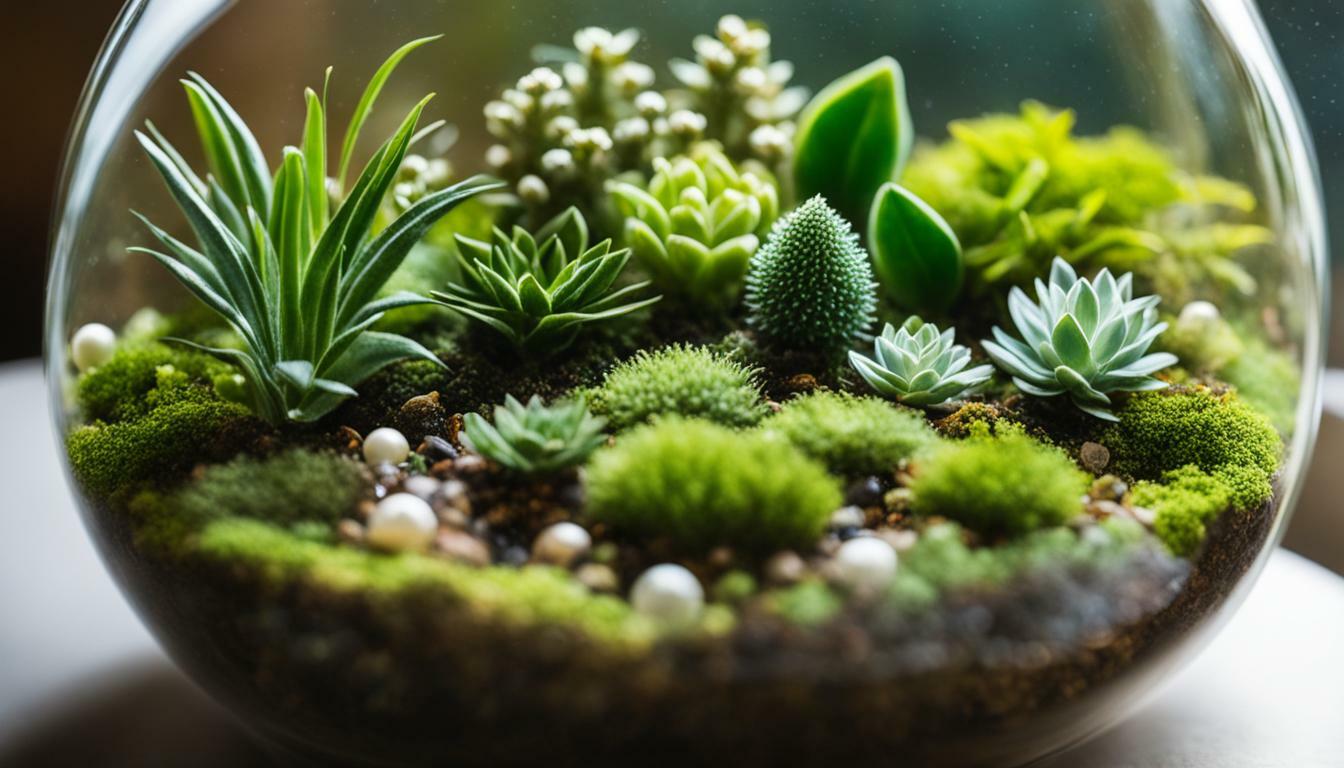If you’ve ever wanted to cultivate your own terrarium plants, now is the perfect time to start. Creating a miniature garden with lush greenery and unique plants can bring a touch of nature into your home while adding a stylish and eye-catching element to your decor. In this article, we will guide you through the process of growing your own terrarium plants, focusing on popular varieties like the String of Pearls.
Before we delve into the details, let’s take a quick look at what terrarium plants are. Terrarium plants are small plants that are specifically suited for growing in enclosed glass or plastic containers. They thrive in the warm and humid environment created within the terrarium, making them an excellent choice for indoor gardening.
To start your terrarium adventure, you’ll need to gather some basic supplies. These include a suitable container, a soil mix that promotes moisture retention and drainage, and of course, the plants themselves. The container should ideally be made of clear glass or plastic to allow for maximum light penetration, which is crucial for the plants’ photosynthesis process.
When choosing the plants for your terrarium, it’s important to consider their light and moisture requirements. Opt for plants that have similar needs to ensure they thrive together in the enclosed environment. Additionally, think about the height, texture, and color of the plants to create a visually appealing arrangement. The String of Pearls, with its cascading stems of round, bead-like leaves, is a popular choice for terrarium enthusiasts due to its unique and delicate appearance.
Once you have all your supplies, it’s time to get your hands dirty. Start by adding a layer of sterilized soil mix to the bottom of your container. Aim for a depth of about 1 ½ to 3 inches, depending on the size of your plants. Moisten the soil before placing the plants, as this will help them establish their roots more easily.
Gently remove the plants from their pots, being careful not to damage the delicate roots. Shake off any excess soil and arrange the plants in your terrarium, taking care not to overcrowd them. Leave enough space for growth and ensure that the leaves do not touch the walls of the container, as this can lead to rot or moisture-related issues.
Now that your plants are snugly nestled in their new home, it’s time to provide them with water. The amount of watering required will depend on whether you have a closed or open terrarium. Closed terrariums create a self-sustaining mini-ecosystem, where water condenses on the walls and trickles back down into the soil. These require very little watering, usually once every few weeks. On the other hand, open terrariums will need more frequent watering, but be cautious not to overdo it and cause root rot.
Place your terrarium in a location with moderate light, as too much direct sunlight can scorch the delicate leaves. Periodically rotate the container to ensure all sides of the plants receive equal amounts of light. Prune the plants as needed to maintain their shape and prevent overcrowding. With regular care and attention, your terrarium will flourish and provide you with a beautiful and low-maintenance miniature garden.
- Choose a clear glass or plastic container for maximum light penetration.
- Opt for plants with similar light and moisture requirements.
- The String of Pearls is a popular choice for its unique appearance.
- Add a layer of sterilized soil mix and moisten before planting.
- Water sparingly, depending on the type of terrarium.
- Place the terrarium in a location with moderate light.
- Prune the plants to maintain their shape and prevent overcrowding.
Choosing the Right Container and Soil Mix for your Terrarium
Before you start planting, it’s important to select the right container and soil mix for your terrarium. The container you choose will not only serve as the home for your miniature plants but also play a crucial role in maintaining the ideal environment for their growth.
When it comes to choosing a container, opt for one that is made of clear glass or plastic. This allows for maximum light penetration, which is essential for photosynthesis. Additionally, a transparent container allows you to admire the beauty of your terrarium plants from all angles.
Next, consider the soil mix. It’s crucial to select a sterilized soil mix that provides good moisture retention and drainage. This will help prevent waterlogging and root rot, ensuring the health and longevity of your terrarium plants. Add about 1 ½ to 3 inches of soil to the container and moisten it before adding the plants.
To create a visually appealing terrarium, you can incorporate different layers of materials such as activated charcoal, pebbles, or moss. These layers not only enhance the aesthetics but also aid in water filtration and root aeration.
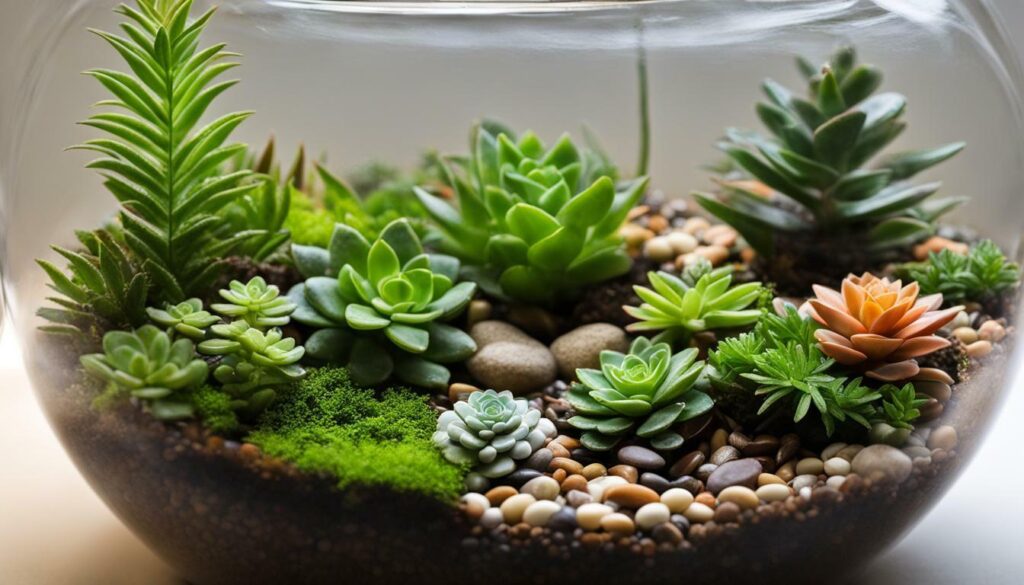
| Container Types | Advantages | Disadvantages |
|---|---|---|
| Glass containers | Provide maximum light penetration. Showcase the beauty of the terrarium. | More fragile. Can be heavy and difficult to move. |
| Plastic containers | Lightweight and easy to move. Often come with built-in ventilation. | May not have the same aesthetic appeal as glass containers. |
“The right container and soil mix are essential for creating a healthy and vibrant terrarium. Choose a container that allows for maximum light penetration, and select a sterilized soil mix that provides good moisture retention and drainage. With the right foundation, your terrarium plants will thrive.”
In conclusion, selecting the right container and soil mix sets the stage for successful terrarium gardening. By choosing a container that maximizes light penetration and a soil mix that promotes moisture retention and drainage, you are providing your terrarium plants with the ideal conditions for growth. Remember to consider the advantages and disadvantages of different container types and get creative with the layers in your terrarium. With the right choices, you’ll be on your way to creating a beautiful and low-maintenance miniature garden.
Selecting Suitable Plants for your Terrarium
To create a stunning terrarium, you need to carefully select the plants that will thrive in this unique ecosystem. When choosing plants for your terrarium, consider their light and moisture requirements, as well as their height, texture, and color. Here are some excellent options for terrarium plants:
- Nerve plants (Fittonia): These small plants feature beautifully patterned leaves in vibrant colors, making them an eye-catching addition to any terrarium.
- Polka dot plants (Hypoestes): Known for their speckled leaves, polka dot plants come in a variety of colors and sizes, adding a touch of whimsy to your miniature garden.
- Rex begonias: With their stunning foliage and unique textures, rex begonias create a dramatic and lush look in a terrarium.
- Baby tears (Soleirolia soleirolii): These delicate and cascading plants form a lush carpet, providing a soft and serene backdrop for your terrarium.
- Succulents like the String of Pearls (Senecio rowleyanus): These plants are not only visually striking with their trailing pearl-like leaves, but they also thrive in the well-draining conditions of a terrarium.
By selecting a variety of plants with similar care requirements, you can create a harmonious and visually appealing terrarium that will flourish for years to come.
Table 1: Recommended Terrarium Plants
| Plant | Light Requirements | Moisture Requirements | Height |
|---|---|---|---|
| Nerve plants (Fittonia) | Medium to bright indirect light | Moist soil | 4-12 inches |
| Polka dot plants (Hypoestes) | Medium to bright indirect light | Moist soil | 6-12 inches |
| Rex begonias | Medium to bright indirect light | Moist soil | 6-12 inches |
| Baby tears (Soleirolia soleirolii) | Bright indirect light | Moist soil | 1-2 inches |
| Succulents (Senecio rowleyanus) | Bright indirect light | Well-draining soil | 6-12 inches |
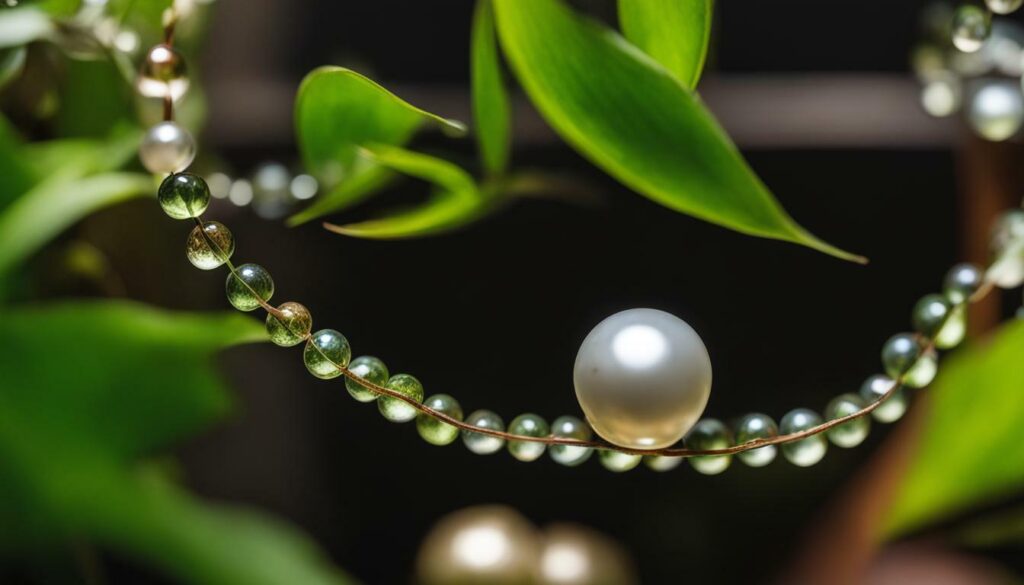
With these plant options and their respective care requirements in mind, you can confidently create a terrarium that suits your style and provides a beautiful and low-maintenance miniature garden in your home.
Planting and Arranging Your Terrarium Plants
Now that you have your terrarium plants ready, it’s time to carefully plant and arrange them in your chosen container. Follow these steps for successful planting and arrangement:
- Carefully remove the plants from their pots, gently loosening the roots with your fingers.
- Clean off excess soil from the roots and trim any damaged or overly long roots.
- Start by adding a layer of soil to the bottom of the container. The depth will depend on the size of your plants, but aim for about 1 ½ to 3 inches.
- Moisten the soil to provide a good foundation for the plants.
- Begin placing your plants in the container, starting with the tallest ones at the back. Consider the height, texture, and color of each plant to create an aesthetically pleasing arrangement.
- Space the plants out, allowing room for growth, and avoid having leaves touch the walls of the container to prevent moisture build-up.
- Once all the plants are in place, add more soil around the roots, gently pressing it down to secure the plants.
- Water the terrarium lightly, being careful not to oversaturate the soil. Closed terrariums require less water, as they develop their own ecosystem where water condenses and trickles back down into the soil.
- Consider adding decorative elements like rocks or moss to enhance the overall look of your terrarium.
Remember to place your terrarium in a location with moderate light levels. Avoid direct sunlight, as it can cause the temperature inside the terrarium to rise too high. Periodically check and prune your plants as needed, removing any dead or yellowing leaves. With proper care and maintenance, your terrarium will thrive and provide you with a beautiful miniature garden to enjoy.
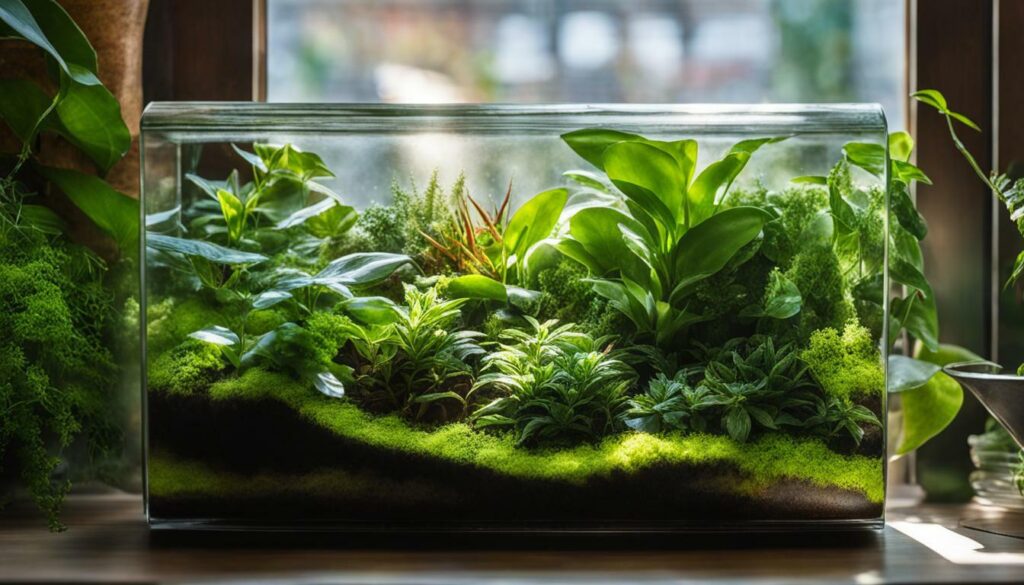
| Plant | Light Requirements | Watering Frequency |
|---|---|---|
| Nerve Plant (Fittonia) | Medium to bright indirect light | Keep soil consistently moist |
| Polka Dot Plant (Hypoestes) | Medium to bright indirect light | Keep soil lightly moist |
| Rex Begonia | Bright indirect light | Allow the top inch of soil to dry out before watering |
| Baby Tears (Soleirolia soleirolii) | Bright indirect light | Keep soil consistently moist |
| String of Pearls (Senecio rowleyanus) | Bright indirect light | Allow the top inch of soil to dry out before watering |
Watering and Caring for your Terrarium
Taking care of your terrarium plants is relatively easy, but it’s important to understand how to properly water and care for them. Maintaining the right moisture levels is crucial for the health and longevity of your miniature garden. Here are some essential tips to keep your terrarium thriving:
- Monitor the moisture levels: Check the soil regularly to determine if it needs watering. The frequency of watering depends on the type of terrarium and the plants you have chosen. Closed terrariums create a self-contained ecosystem where water condenses and waters the plants, so they require less frequent watering compared to open terrariums.
- Water in moderation: When watering your terrarium, be cautious not to overwater. Too much water can lead to root rot and the death of your plants. Use a spray bottle or watering can with a narrow spout to carefully water around the base of the plants, avoiding the leaves as much as possible.
- Consider the humidity: Terrariums naturally create a humid environment, but it’s essential to ensure proper air circulation to prevent excess humidity. If you notice excessive condensation on the walls of your terrarium, leave it open for a while to allow the moisture to evaporate.
- Prune as needed: Regular pruning helps maintain the shape and appearance of your terrarium plants. Remove any dead or yellowing leaves and trim excessive growth to keep your plants tidy. This will also allow for better air circulation and prevent overcrowding.
- Keep an eye out for pests: Although terrariums are relatively pest-resistant, it’s still important to monitor for any signs of insects or diseases. If you notice any pests, remove them manually or use organic pest control methods to minimize damage to your plants.
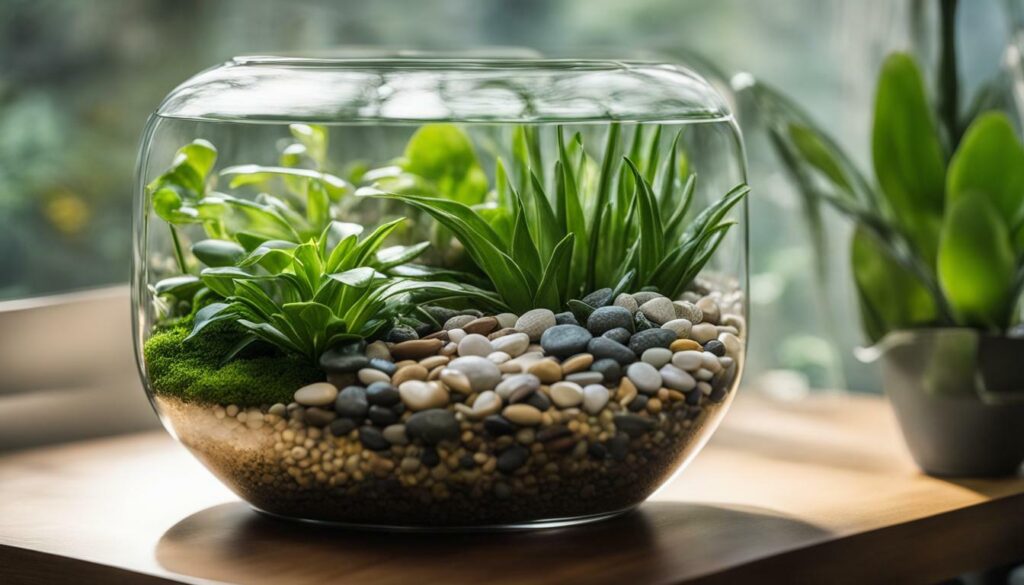
By following these tips, you can ensure that your terrarium plants remain healthy and vibrant. Remember to observe your plants closely and make adjustments as needed to create an optimal environment for their growth. With a little care and attention, your terrarium will continue to provide you with a beautiful miniature garden to enjoy for years to come.
| Benefits of Proper Watering and Care | Proper watering and care of your terrarium plants offer several benefits: |
|---|---|
| 1. Longevity | By providing the right amount of water and care, you can extend the lifespan of your terrarium plants, allowing them to thrive for years. |
| 2. Low Maintenance | Terrariums are known for their low maintenance requirements. Proper watering and care practices help keep this low-maintenance gardening trend hassle-free. |
| 3. Visual Appeal | Healthy and well-cared-for plants enhance the visual appeal of your terrarium, creating a stunning display of miniature greenery in your home. |
| 4. Stress Relief | Tending to your terrarium can be a therapeutic activity, providing a sense of calm and relaxation as you connect with nature. |
Lighting Requirements and Placement of your Terrarium
Finding the right spot to place your terrarium and understanding its lighting requirements are key to maintaining healthy and vibrant plants. Different types of terrariums have varying light needs, so it’s important to consider the specific plants you have chosen and their light preferences.
Most terrarium plants, especially those suited for indoor environments, thrive in bright, indirect light. Placing your terrarium near a north-facing window or a few feet away from a south-facing window is ideal. This allows the plants to receive adequate light without being exposed to direct sunlight, which can cause leaf burn.
If your terrarium is situated in a room with limited natural light, you can supplement it with artificial lighting. LED grow lights are a popular choice as they provide the necessary spectrum of light for photosynthesis. Position the lights about 6 to 12 inches above the terrarium and set them on a timer for 10 to 12 hours of artificial light per day.
Remember to monitor the light levels in your terrarium regularly. If you notice signs of stress, such as pale leaves or stunted growth, adjust the placement or intensity of the light accordingly. Each plant has its own specific light requirements, so it’s essential to research and understand the needs of the particular plants in your terrarium.
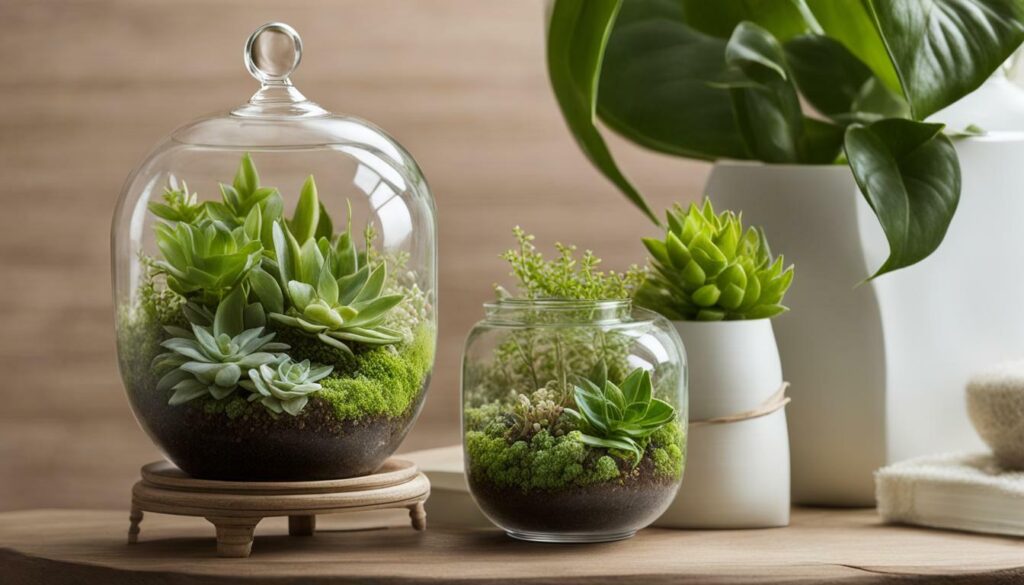
In summary, finding the right lighting spot for your terrarium is crucial for the health and growth of your plants. Consider the natural light conditions in your home or supplement with artificial lighting as needed. Monitor the light levels regularly and make adjustments accordingly to ensure your terrarium plants thrive and bring beauty to your indoor space.
Pruning and Maintenance of your Terrarium Plants
Keeping your terrarium plants well-maintained will help them thrive and continue to add beauty to your indoor space. Regular pruning is essential to maintain the shape and size of your plants, as well as to encourage new growth. Use clean, sharp scissors or pruning shears to carefully trim any yellowing or dead leaves. Be mindful not to remove too many leaves at once, as this can stress the plant.
When pruning, it’s important to consider the growth habit of each plant. Some plants, like the String of Pearls, have trailing stems that can be trimmed back to control their length. Other plants, like the nerve plant or rex begonia, may benefit from occasional pinching to encourage bushier growth. Pay attention to any signs of overcrowding or competition for light and remove excess growth accordingly.
In addition to pruning, regular maintenance tasks will help keep your terrarium plants healthy. Check the soil moisture level regularly and water as needed, being careful not to overwater. If you notice any pests, such as aphids or spider mites, gently remove them by hand or treat with an organic insecticidal soap.
To maintain a clean and attractive terrarium, wipe down the inside of the container with a damp cloth or sponge to remove any dust or water spots. This will help maximize light penetration and ensure your plants receive the necessary sunlight for photosynthesis. Avoid using any chemicals or cleaning agents that could harm your plants.
By implementing proper pruning and maintenance practices, you can enjoy a thriving terrarium that adds a touch of nature and beauty to your indoor space. Take the time to care for your terrarium plants, and they will reward you with their lush greenery and effortless elegance.
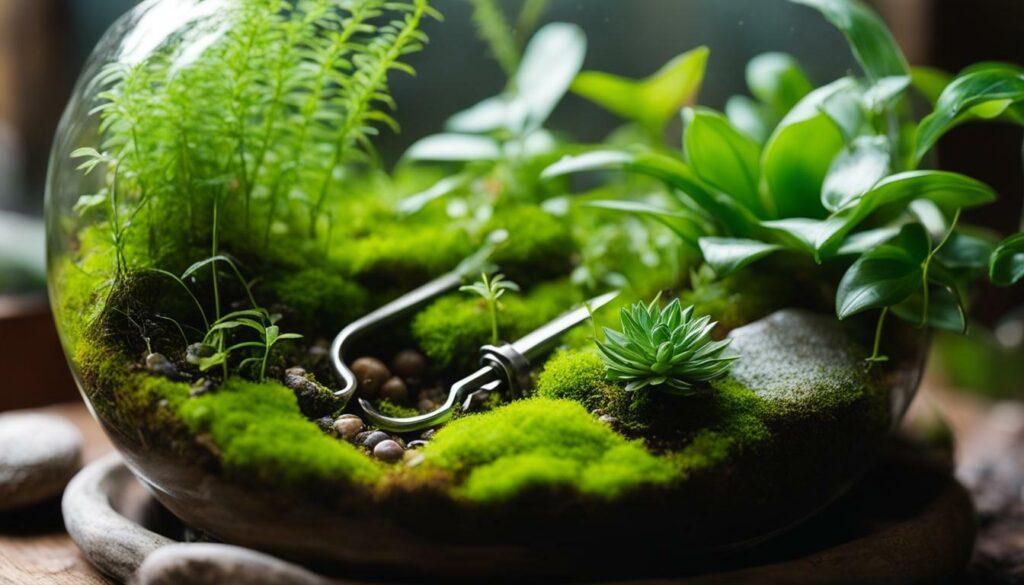
| Pruning and Maintenance Tips: | Plant Selection: |
|---|---|
|
|
Troubleshooting Common Issues in Terrarium Gardening
Even the most experienced gardeners may face challenges when it comes to terrarium gardening, but there are solutions to common issues. By understanding and addressing these problems, you can ensure the health and success of your miniature plants.
Pest Infestation
Pests such as aphids, mites, and fungus gnats can wreak havoc on your terrarium plants. To combat these pests, start by regularly inspecting your plants for any signs of infestation. If you notice tiny bugs, discolored leaves, or webbing, take immediate action. One effective solution is to use organic insecticidal soap or neem oil, which can be applied directly to the affected areas. Additionally, keeping your terrarium clean and well-maintained will help prevent infestations in the first place.
Mold and Fungal Growth
Mold and fungal growth are common issues in terrariums, especially in closed or high humidity environments. To prevent mold and fungus from taking over, ensure proper ventilation by occasionally opening the lid or removing the lid for a short period of time. Avoid overwatering your terrarium, as excess moisture can create the perfect conditions for mold and fungus to thrive. If you notice any mold or fungus, carefully remove the affected areas and adjust your watering routine accordingly to maintain a healthy balance of moisture.
Yellowing or Browning Leaves
If you notice yellowing or browning leaves on your terrarium plants, it could be a sign of overwatering, poor drainage, or insufficient light. To address this issue, check the soil moisture levels and adjust your watering schedule accordingly. If the soil feels overly wet, allow it to dry out before watering again. Ensure that your terrarium has proper drainage by using a layer of rocks or activated charcoal at the bottom of the container. Lastly, make sure your plants are receiving adequate light by placing them near a bright window or using artificial grow lights if needed.
| Issue | Solution |
|---|---|
| Pest Infestation | Use organic insecticidal soap or neem oil Regularly inspect and clean your terrarium |
| Mold and Fungal Growth | Ensure proper ventilation Avoid overwatering Remove affected areas and adjust watering routine |
| Yellowing or Browning Leaves | Check soil moisture and adjust watering schedule Ensure proper drainage Provide adequate light |
Remember, terrarium gardening is a learning process, and it may take some trial and error to find the perfect balance for your plants. With patience and attention to detail, you can overcome these common issues and enjoy a thriving terrarium filled with beautiful plants.
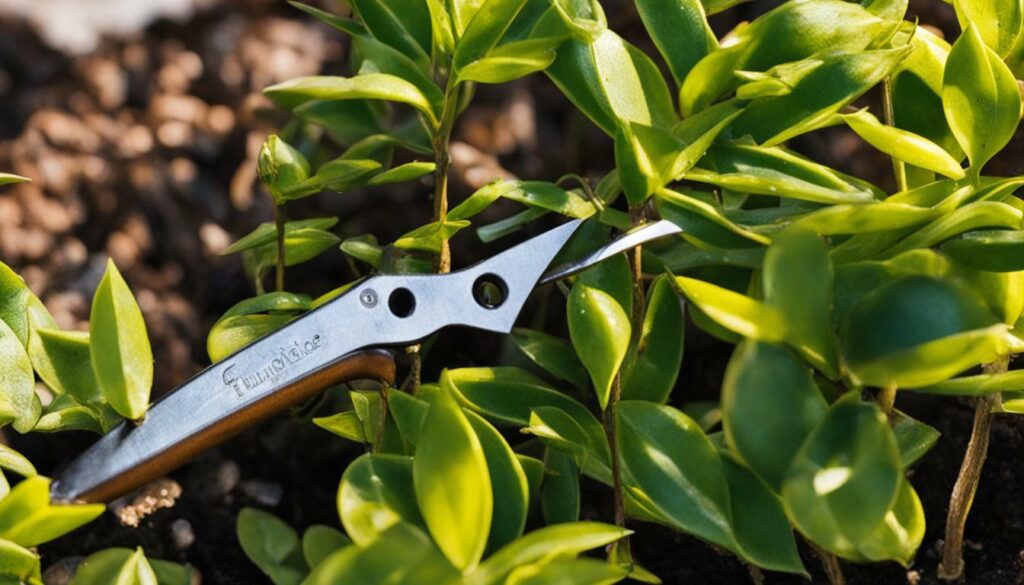
Growing your own terrarium plants is a rewarding and enjoyable experience that allows you to create a stunning miniature garden right in your own home. With just a few simple steps, you can bring the beauty of nature indoors and enjoy the tranquility and charm of a terrarium.
To start, choose a suitable container made of clear glass or plastic, allowing for maximum light penetration. Select a sterilized soil mix that provides good moisture retention and drainage. Add the soil to the container, moisten it, and you’re ready to add the plants.
When selecting plants, consider their light and moisture requirements, as well as their height, texture, and color. Nerve plants, polka dot plants, rex begonias, baby tears, and succulents like the String of Pearls are all excellent choices for terrariums. Carefully remove the plants from their pots, clean off excess soil, and arrange them in the terrarium, keeping leaves from touching the walls for optimal growth.
Watering your terrarium will depend on whether it is closed or open. Closed terrariums require minimal watering, as they develop a natural rain cycle, with water condensing on the walls and trickling back into the soil. Open terrariums will need more frequent watering, but be cautious not to overwater and cause root rot.
Place your terrarium in a location with moderate light, and periodically prune the plants to maintain their desired shape and size. With proper care, your terrarium will thrive and provide a beautiful miniature garden that you can enjoy for years to come.
Can I Grow String of Pearls in a Terrarium at Home?
Yes, you can grow terrarium plants like string of pearls in a terrarium at home. These low-maintenance succulents thrive in the humid environment of a terrarium and can be a beautiful addition to any indoor space. Just make sure to provide them with well-draining soil and indirect sunlight.
FAQ
What is a terrarium?
A terrarium is a miniature garden enclosed in a glass or plastic container. It creates a controlled environment for plants to grow and thrive.
What type of container should I use for a terrarium?
It is best to choose a container made of clear glass or plastic to allow for maximum light penetration. Make sure it has a lid or is able to be covered to create a humid environment.
What kind of soil should I use for a terrarium?
Choose a sterilized soil mix that provides good moisture retention and drainage. This will help prevent root rot and other soil-related issues.
How do I select plants for my terrarium?
Select plants that have similar light and moisture requirements. Consider their height, texture, and color for visual interest. Some suitable plants for terrariums include nerve plants, polka dot plants, rex begonias, baby tears, and succulents like the String of Pearls.
How do I plant and arrange the plants in my terrarium?
Gently remove the plants from their pots, clean off excess soil from the roots, and arrange them in the terrarium. Take care to avoid having leaves touch the walls to prevent rot or mold.
How often should I water my terrarium?
Closed terrariums require very little watering and develop a rain cycle where water condenses on the walls and trickles back down into the soil. Open terrariums will require more frequent watering, but be cautious not to overwater and cause root rot.
Where should I place my terrarium for optimal growth?
Place your terrarium in a location with moderate light. Avoid direct sunlight, as it can overheat the enclosed environment and damage the plants.
How do I prune and maintain my terrarium plants?
Periodically prune your terrarium plants to maintain their shape and prevent overcrowding. Remove any dead or yellowing leaves. Additionally, remove any excessive growth to maintain the desired size of the plants.
What are some common issues in terrarium gardening?
Common issues include overwatering, inadequate lighting, and pest infestations. Luckily, these issues can be easily resolved with proper care and attention.
Why should I grow my own terrarium plants?
Growing your own terrarium plants allows you to enjoy the beauty of miniature gardens in your own home. It is a low-maintenance and rewarding gardening activity that can provide years of enjoyment.

